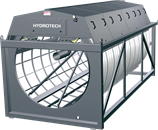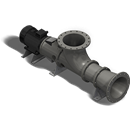The Most Important Tool for a Successful RAS Project
When preparing to design and build an agricultural business, careful planning of production is critical to achieving consistency in how the product is produced, harvested, and delivered to market. The goal of such planning is to define the scale of the facility and the major elements of the infrastructure required to achieve the production goals. Regardless of what you are growing (greenhouse vegetables, hogs, chickens, or fish), strategic production planning in the early stages of design will set a foundation for efficient design execution, and for financial and operational success of the project.
Bioplanning in Aquaculture Design
In aquaculture, production planning at the time of design is often referred to as "bioplanning". Bioplanning is a complex, multi-variable optimization exercise that is used to determine the key design criteria for the facility. As with most optimization exercises, there is no one “correct” solution, but rather a whole range of solutions, each arriving at the same destination but each following a different path. The design choices made at the bioplanning stage provide the biggest opportunity to affect the total scale and cost of the facility and will often determine the long-term sustainability of the solution.
At the core of any bioplanning process is a numerical model that allows simulation of the production results based on many input variables. Some of the many inputs used in modelling include entry interval, growth rate, feed conversion, timing of fish movement and grading events, fish size distribution at each stage of growth, and harvest timing. It should be noted that the outputs of modelling will only be as good as the input data. Accurate, quality information is the key. Inferences, interpolations, or extrapolations in place of real data only serve to dilute confidence in the model and make the designers job more difficult. Key outputs of the bioplan model will include the total number and size of the culture tanks, the number and size of water treatment modules, design limits for biomass, density, and feed load, time-based values for inventory, feed use, mortality and harvest biomass, and a map of how fish move through the facility to meet the production target.
Bioplan Efficiency and Flexibility
Bioplan efficiency is typically measured by feed capacity and/or volume utilization; flexibility is measured by the ability to accommodate variance from plan. An extremely efficient bioplan will usually lack flexibility. For example, a facility plan may be extremely efficient, with every tank in use every week and all tanks run to maximum density. However, to meet production plan in such a facility will require that fish grow exactly as per the design curve, and that a very precise schedule of fish movements be maintained. Planning to this level of precision is unrealistic and will likely result in immediately deviating from plan. In practice, it is rare for actual production to exactly match design assumptions. Fish groups will not grow the same way every year, some fish groups may be larger or smaller than others, and changing market requirements can dictate changes in target size or numbers. It is for this reason that the design bioplan must strike a balance, sacrificing some efficiency in favor of operational flexibility.
The interplay of cost, complexity, and production risk is also critical. The following diagram demonstrates how certain design choices will impact these variables and how there must be a balance to achieve an optimal design. The point of optimization will differ for each project depending on a project owner’s priorities, preferences, and risk tolerance.
Case Study
A RAS project owner has chosen a production target of 5,000 MT HOG of market sized Atlantic Salmon. They have planned for an introduction interval of four (4) cohorts per year. Choosing fewer introductions per year results in the need for fewer and larger culture tanks because the cohort groups are larger and because there are fewer cohort groups held concurrently. They have also chosen to place more culture tanks on a single treatment to minimize the number of treatment modules required. Further, it was decided that cohorts will be mixed within each production module, allowing for an averaging of feed loads (mix of high and low tank feed loads). This allows for reduction in the scale of the treatment modules and drives high feed load efficiencies for the site.
In the scenario presented, the decisions made would lower the capex, lower labor requirements, and lower the operational complexity of the facility. While these are all positive impacts, the same decisions can create other challenges including the following (see diagram).
Fewer Introductions
Choosing fewer introductions per year will generally increase size variation at time of harvest as a result of the length of time between first and last harvest (13 weeks in this example). While this may be mitigated with additional fish handling and culling events, the additive stress effects of excessive handling may begin to impact growth performance.
Mixing Juvenile Cohorts
The mixing of juvenile cohorts in the same production module will expose younger fish to older fish, making it difficult to prevent pathogens from cycling through the facility.
Increasing Culture Tanks
Increasing the number of culture tanks on a common treatment may reduce the number of modules that a facility requires but will increase risk. With more fish in a single module, the consequence of a single issue or failure will be higher (e.g., critical mechanical failure, water quality issue, pathogen exposure, or human error).
Collaborative Bioplanning: From Design to Operation
It can be a challenging process to find a balanced bioplan solution that meets all of the project owner's needs and desires. The designer must guide the decision-making process, ensuring that the owner understands their options and the impacts of their decisions. It is also their responsibility to manage the owner’s expectations as what may seem efficient in planning, may not be practical in execution. Collaboration, buy-in from all stakeholders, and solid planning tools are all critical in deriving an optimal bioplan solution.
Ultimately, the bioplan prepared at time of design, while extremely important in planning, is just a starting point used to set design limits and to scale facility infrastructure. After facility startup, operators must continually adapt their production plan, based on real-time fish data, to forecast performance and to plan the use of the fixed facility infrastructure. If the bioplan was well-prepared at time of design, the resulting facility will provide a flexible platform that will allow operators to optimize facility output and successfully reach the production goal 100% of the time.
Who We Are
Since 1998, PR Aqua has been providing our customers with engineered RAS solutions to suit their specific fish production and water quality needs. We work with our customers, many of whom are repeat clients, and some of which are the largest salmon farming companies in the world, to develop innovative systems to grow high quality fish in facilities that are well thought out, are energy efficient, and easy to operate.
PR Aqua prepares bioplans as part of our RAS design process. What we have learned from our experiences and by working cooperatively with industry has allowed us to develop detailed modeling tools and methods that are used to optimize production systems for fish, operators, and project owners.
Discuss Your Project
No matter how big or how small, or how far along your plans are, we can help. PR Aqua's technical knowledge and client commitment are second to none. Let's get started!









